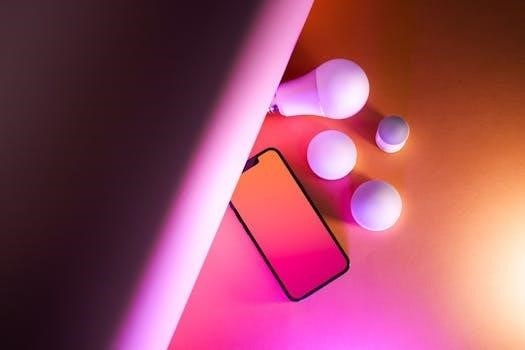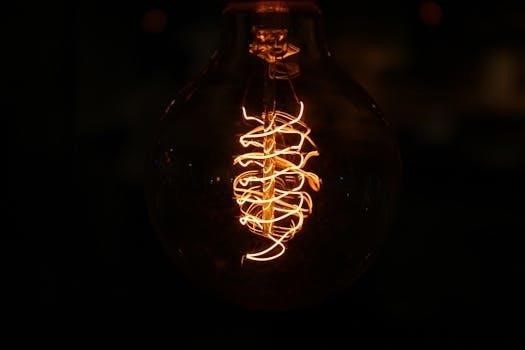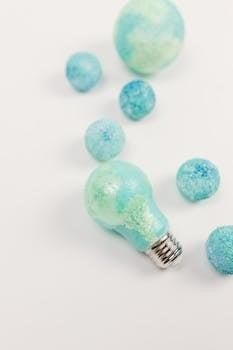Choosing the right light can be confusing! This guide simplifies color temperature using the Kelvin scale. Learn how “warm” and “cool” translate into the light’s appearance. From cozy relaxation to focused work environments, discover the perfect bulb for every room.

Understanding Color Temperature (Kelvin)

Color temperature, measured in Kelvin (K), is a crucial aspect of lighting, influencing the ambiance and functionality of a space. It describes the color of light emitted by a bulb, ranging from warm, reddish tones to cool, bluish hues. Despite the term “temperature,” it doesn’t indicate the heat output of the bulb. Instead, it reflects the perceived color of the light compared to that of a black body radiator heated to that temperature.
Lower Kelvin values (2000K-3000K) produce warm white light, reminiscent of traditional incandescent bulbs, creating a cozy and inviting atmosphere. Higher Kelvin values (4000K-6500K) emit cooler, brighter light, similar to daylight, promoting alertness and focus. Understanding the Kelvin scale allows you to select the appropriate bulbs to achieve the desired mood and functionality in different areas of your home or workspace. Selecting the right color temperature can transform a room.
The Kelvin Scale for Light Bulbs
The Kelvin scale is the standard measurement for expressing the color temperature of light, providing a numerical value that corresponds to the hue emitted by a light bulb. Ranging from warm to cool, the Kelvin scale offers a precise way to understand and select the appropriate lighting for various applications. Lower Kelvin values, typically between 2000K and 3000K, represent warmer light, characterized by yellow and red tones, often associated with relaxation and comfort. These temperatures are ideal for living rooms, bedrooms, and dining areas.
As the Kelvin value increases, the light transitions to a neutral white around 4000K, suitable for general-purpose lighting and workspaces. Higher Kelvin values, ranging from 5000K to 6500K and beyond, produce cooler light with blue undertones, mimicking daylight. This color temperature enhances focus and concentration, making it ideal for offices, workshops, and task lighting. The Kelvin scale empowers consumers to make informed decisions about lighting.
Warm White Light (2000K-3000K)
Warm white light, typically ranging from 2000K to 3000K on the Kelvin scale, emits a gentle, inviting glow reminiscent of traditional incandescent bulbs. This color temperature is characterized by subtle red and yellow hues, creating a cozy and relaxing atmosphere. The warm tones are flattering to skin tones and clothing, making this light ideal for spaces meant for socializing and unwinding.
Consider using warm white light in living rooms, bedrooms, and dining areas to foster a sense of comfort and intimacy. Its gentle illumination is perfect for creating a welcoming ambiance for guests or relaxing after a long day. Warm white light can also help reduce eye strain and fatigue, making it a good choice for reading lamps and bedside lighting.
While warm white light is generally suitable for relaxation, be mindful of its potential to diminish alertness. In workspaces or areas requiring focus, a brighter, cooler light may be more appropriate. When choosing light bulbs, consider the intended use of the space and the desired mood to achieve optimal illumination.
Neutral White Light
Neutral white light, generally found around 3500K to 4500K on the Kelvin scale, offers a balance between the warm tones of lower temperatures and the cooler hues of daylight. This color temperature provides a clean, crisp illumination that is suitable for a variety of settings. It avoids the yellow cast of warm white, while still maintaining a comfortable and inviting ambiance.
Neutral white light is often used in kitchens, bathrooms, and offices. Its balanced color rendition makes it ideal for tasks that require accuracy and focus. It also works well in areas where you want to create a bright and cheerful atmosphere without being overly harsh. This versatile color temperature is a good compromise for those who find warm white too dim or daylight too stark.
When selecting neutral white light, consider the overall design of the space. It complements a wide range of color palettes and styles. However, it may not be the best choice for areas where you want to create a very warm or intimate atmosphere. Experiment with different Kelvin temperatures to find the perfect balance for your needs.
Daylight (5000K and Higher)
Daylight bulbs, boasting color temperatures of 5000K and above, emulate the bright, crisp light of natural sunlight. This high Kelvin range produces a cool, bluish-white light that is ideal for areas where maximum visibility and alertness are desired; Often described as “invigorating,” daylight bulbs are commonly used in task-oriented spaces.
These bulbs excel in workshops, home offices, and art studios, where accurate color perception is crucial. The stark, clear light helps to minimize eye strain and improve focus, making it easier to work on detailed projects. Daylight bulbs are also a popular choice for security lighting, as their brightness can deter intruders.
However, it’s essential to use daylight bulbs judiciously. The cool, intense light can feel harsh or sterile in living areas or bedrooms, where a warmer, more relaxing ambiance is preferred. Consider the specific needs of each space when selecting daylight bulbs to ensure a comfortable and functional lighting scheme. Remember that personal preference plays a significant role in lighting choices.
Color Temperature for Different Rooms

Selecting the right color temperature for each room can dramatically impact the ambiance and functionality of your home. Consider the activities that take place in each space when making your choices. For living rooms and bedrooms, warm white light (2700K-3000K) creates a cozy and inviting atmosphere, perfect for relaxation and socializing. These warmer tones are flattering to skin tones and clothing, making them ideal for spaces where comfort is paramount.
In kitchens and bathrooms, a slightly cooler, neutral white light (3500K-4000K) provides better visibility for tasks such as cooking and grooming. This color temperature offers a balance between warmth and brightness, ensuring a functional and comfortable environment. For home offices and workshops, daylight bulbs (5000K and higher) can enhance focus and productivity.
Hallways and entryways can benefit from a mid-range color temperature (3000K-3500K) to create a welcoming and well-lit transition between rooms. Ultimately, the best color temperature for each room depends on your personal preferences and the specific needs of the space. Experiment with different options to find the perfect balance of light and ambiance for your home.
Color Temperature for Reading
Choosing the right color temperature for reading lamps is crucial for eye comfort and focus. While personal preference plays a role, a general guideline suggests a color temperature of 2700K to 3000K for optimal reading conditions. This warm white lighting creates a comfortable and relaxing atmosphere, reducing eye strain and fatigue during extended reading sessions.
The warm tones mimic the soothing light of traditional incandescent bulbs, making the reading experience more enjoyable. Avoid using daylight bulbs (5000K and higher) for reading, as the cooler, bluish light can be too harsh and may cause eye fatigue. A neutral white light (3500K-4000K) can also be suitable for reading, but it may not provide the same level of relaxation as warm white light.
Experiment with different color temperatures to find what works best for your eyes and reading habits. Consider the ambient lighting in the room and adjust the color temperature of your reading lamp accordingly. Ultimately, the goal is to create a comfortable and inviting reading environment that allows you to focus on the material without straining your eyes.
Personal Preference
While guidelines and recommendations exist for choosing light bulb color temperatures, the ultimate decision rests on personal preference. What one person finds comfortable and inviting, another might perceive as too warm or too cool. Factors like individual sensitivity to light, the existing décor of the room, and the intended use of the space all contribute to shaping personal preferences.
If you’re new to LED bulbs, you may find that warm white bulbs (2700K-3000K) feel more familiar, as they closely resemble the color temperature of traditional incandescent bulbs. Others may prefer the brighter, more energizing light of neutral white or even daylight bulbs. Experimenting with different color temperatures is the best way to discover what suits your individual needs and tastes.

Consider purchasing a few different bulbs with varying color temperatures and trying them out in different rooms. Pay attention to how the light affects your mood, your ability to focus, and the overall ambiance of the space. Don’t be afraid to deviate from the recommendations and choose what feels most comfortable and visually appealing to you. Ultimately, the “right” color temperature is the one that you enjoy the most.
LED Color Temperature Range
LED bulbs offer an extensive range of color temperatures, providing unparalleled flexibility in creating the desired ambiance for any space. This broad spectrum is one of the key advantages of LEDs over traditional incandescent or fluorescent lighting. The color temperature of an LED, measured in Kelvin (K), dictates whether the light appears warm (yellowish) or cool (bluish).
Typically, the LED color temperature range spans from approximately 2000K to 6500K or even higher in some specialized applications. At the lower end of the scale (2000K-3000K), you’ll find warm white LEDs, ideal for creating a cozy and relaxing atmosphere in living rooms, bedrooms, and dining areas. These bulbs emit a soft, inviting light reminiscent of traditional incandescent bulbs.
Moving up the scale, neutral white LEDs (3500K-4500K) provide a more balanced and natural-looking light, suitable for kitchens, bathrooms, and home offices. Daylight LEDs (5000K and above) emit a crisp, bright light that mimics natural daylight, making them perfect for task lighting in workshops, garages, and reading nooks. The wide variety ensures a perfect match for every need!
